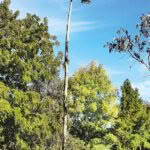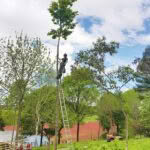Why oak-tree enthusiasts want oaks planted all over New Zealand (especially as timber)
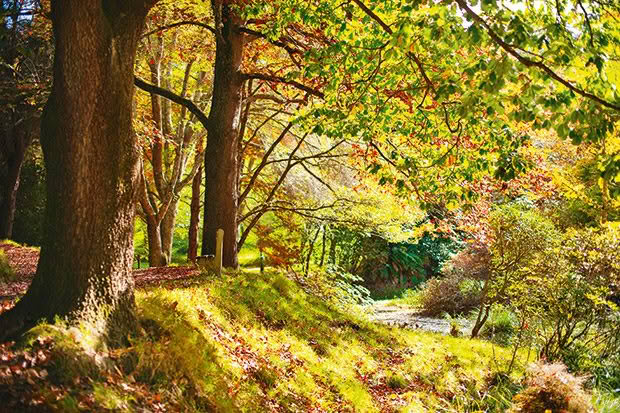
A passionate group are hunting for Aotearoa’s most magnificent oak trees to make sure we can all share the love.
Words & images: Rachel Rose
Oak lovers are a quirky kind. Douglas ‘Cookie’ Cook liked to garden naked, save for one gumboot on the foot used on his planting spade. He spent 55 years and all his money planting what is now New Zealand’s national arboretum, Eastwoodhill, near Gisborne. Among the 500 species of trees, shrubs, and climbers from the Northern Hemisphere are 100 oaks of 80 different species.
The threat of nuclear weapons galvanised Cookie during the Cold War era. He saw his collection of trees, tucked away at the bottom of the world, as an ‘arboreal ark’. That concept is still relevant because New Zealand is a safe haven from the nasty diseases threatening oaks in the Northern Hemisphere.
Oak trees bring out the passion in people. Cookie’s work inspired Bob Berry to establish Hackfalls Arboretum at Tiniroto, an hour’s drive south of Eastwoodhill. The site turned out to be almost perfect, and Hackfalls is now internationally renowned for its collection of Mexican oaks (about 45 species, plus hybrids). In total, it has about 150 species of oaks.
Another great quercophile (lover of oaks) was Don Hamilton. A notable horticulturist from the Bay of Plenty, Don was passionate about the potential of exotic hardwoods as timber trees.
While he didn’t own land until late in his life, that didn’t stop him from spreading his love of oaks. He planted and nurtured trees on public land – with the approval of local officials – and was also the source for some of the oaks planted at Eastwoodhill and Hackfalls.
SAVING OAKS TODAY
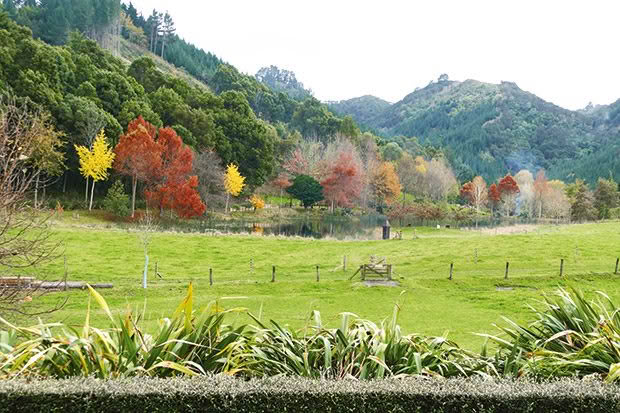
The keen and passionate folks behind Oaks New Zealand continuing the legacy left by Don, Cookie, Bob, and others. I got involved several years ago when I went on a trip with Oaks NZ founders Eric Cairns and Kathryn Hurr.
The goal was to locate oaks grown from acorns Don had imported from overseas back in the halcyon days when importing plant material was legal. Don wasn’t great at record-keeping, so it has been a nationwide adventure to piece together his contributions in the years since he died.
Oaks NZ is part of the New Zealand Farm Forestry Association and aims to fill part of the gap left by Don’s passing.
It’s driven by a handful of hard-working and very knowledgeable volunteers. There is NZ Tree Crops guru Eric, botanist Kathryn, farmer Kees Weytmans, and more recently Gary Fleming, a top-notch farm forester from Canterbury. Plus there’s me, tagging along and taking notes.
‘Mighty oaks from little acorns grow’, and that’s the group’s goal. Its long-term plan is to see oaks planted all over the country, especially as timber trees. Part of the mission is identifying which of the 600 or so oak species are in NZ. Officially it’s 150, but Oaks NZ is hoping there are more.
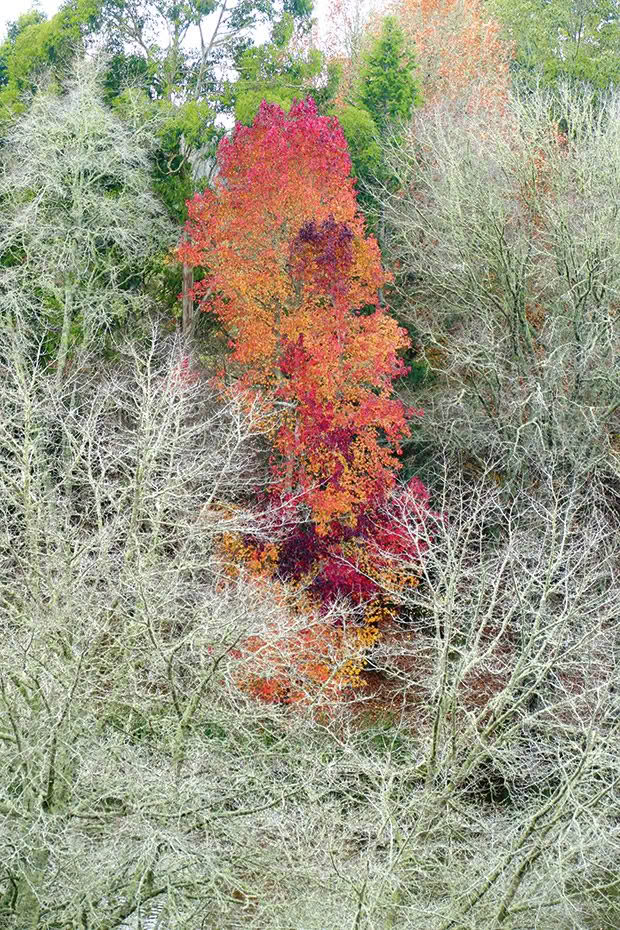
Quercus shumardii (Shumard’s oak) offers a blaze of late colour in early winter at Hackfalls Arboretum.
The plan is to track down the rare ones. It’s important to improve the genetic diversity of what is being propagated as today it’s very difficult and expensive to bring new oak genetics into NZ. Acorns must be quarantined for up to two years before getting biosecurity clearance.
There are also exciting research trials underway around the country. Seven deciduous red oaks are growing at Eastwoodhill Arboretum on a hectare of its woodlot block, and at Rewanui, a trust-owned research station in the Wairarapa. Amenity plantings have gone in at Battle Hill Farm Forest Park in Wellington.
The seven Quercus species in Oak NZ’s deciduous red oak trial were chosen for their fast growth:
■ Q. rubra (Northern red oak)
■ Q. palustris (pin oak)
■ Q. texana syn. nuttallii (Nuttal’s oak)
■ Q. shumardii (Shumard’s oak)
■ Q. ellipsoidalis (Northern pin oak)
■ Q. kelloggii (California black oak)
■ Q. pagoda (cherrybark oak)
These range from well-known to rare in New Zealand. Seedlings are being planted in clusters, and then thinned to select the best ones.
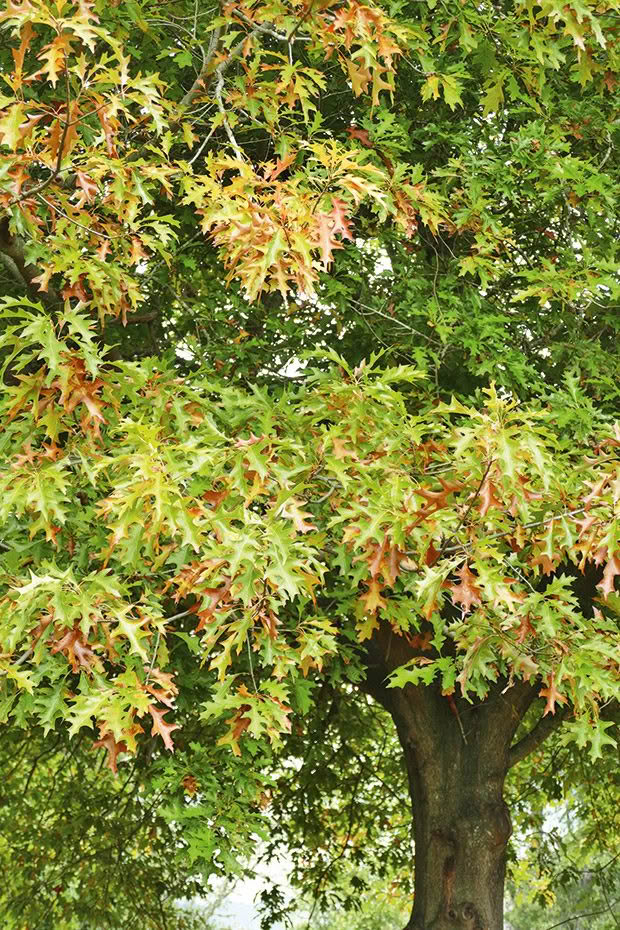
Quercus texana at Hackfalls.
Oaks NZ is also in the early stages of a partnership that will see oaks planted and professionally managed on farms around the country, and is providing advice on oaks in a production/carbon forest being established in Whanganui.
Eric is planting more Mexican species on his block near Wellington. I’ve got 1ha of North American oaks, some Mexicans and specimen trees going in. Kees has superbly tended woodlots on his Gisborne property. Gary planted his first oaks at the tender age of 17 and now has 50 different Quercus species, with more rare oaks going in this winter.
You can keep up to date with Oak NZ’s plans, ask questions, pass on details of significant oaks in your district, share photos, and just join in the ‘quercy’ fun on the Oaks New Zealand Facebook page.
THE ACORN TRIALS
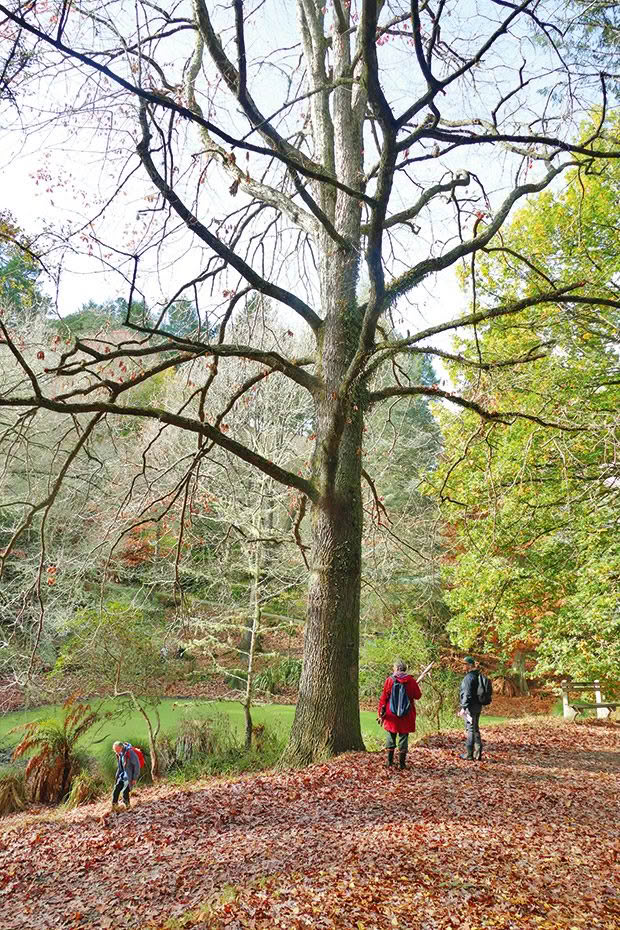
Eric and Annette Cairns and Kathryn Hurr (at right) searching for elusive acorns under Eastwoodhill’s magnificent American white oak, Quercus alba. Normally the pond’s water level is much higher and the sweet little acorns drop into it. It was worth spending 20 minutes squirrelling away to collect whatever we could find on our visit.
John and Liz Hancock run sheep and cattle on 65ha in drought-prone Martinborough. John says they lost sheep that gorged on Q. robur and Q. petraea acorns. They’re now trialling cork (Q. suber) and Holm oaks (Q. ilex) specifically as an alternative feed at the end of dry summers.
“Stock must be introduced when there are very few acorns on the ground,” John warns. “But I’ve never lost one from eating acorns from the suber and ilex.
“And boy, do they go for them! Particularly clever sheep like Sussex, you put them in a paddock and they head straight for the trees. They will push each other out of the way to get them.”
However, the oaks aren’t proving as valuable as the Hancocks hoped. Q. ilex doesn’t produce acorns until long after the worst late-summer feed shortages are over. Q. suber has better timing but doesn’t produce a decent crop of acorns every year.
There’s no toxicity risk to deer. Oaks NZ member Gary Fleming feeds pruned branches and acorns to his deer, a common practice in the Himalayas. “They love it,” he says. “They’ll walk over chicory and clover to get to evergreen oaks.”
PIGS LOVE ACORNS
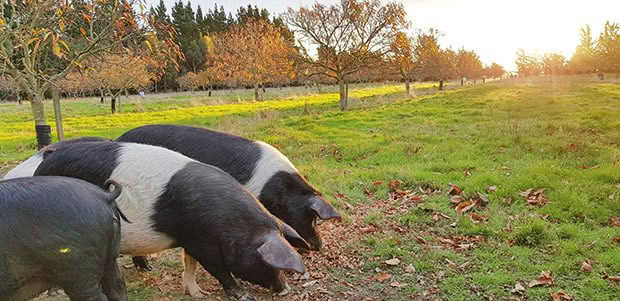
Photo: Poaka Farm.
At Poaka Farm in Canterbury, heritage breed pigs freely range through their own chestnut orchards. Some 20-30 tonnes of acorns are also collected from Hagley Park each autumn to feed the pigs. Poaka Farm’s Josh Hill says the acorns are also scoffed by his rare breed sheep. They prefer it to other feed and he’s never had an issue with stock losses.
Pigs thrive on acorns. The famed black Ibérico pigs in Spain and Portugal are finished on acorns, eating up to 2kg a day. The result is a sweet, complex flavour in the meat.
Case study: How to farm oak trees
Who: Kees and Kay Weytmans
Where: Waihirere, 15km north of Gisborne
Land: 32ha (70 acres)
What: eco lodge and venue, forestry, highland cattle, deer, sheep
Web: knapdale.co.nz
In the best romantic tradition of the Kiwi OE, Dutchman Kees (pronounced Case) Weytmans met his wife-to-be Kay while she was in Nepal and followed her home to her family farm near Gisborne.
Thirty-four years later, they preside over a beautiful property where Kees’ love of trees in general and oaks in particular is evident everywhere you look. Highland cattle and deer graze among well-tended trees. Autumn puts on a glorious display of colour around their stunning Knapdale Eco Lodge, a wedding and function venue built from locally grown timbers.
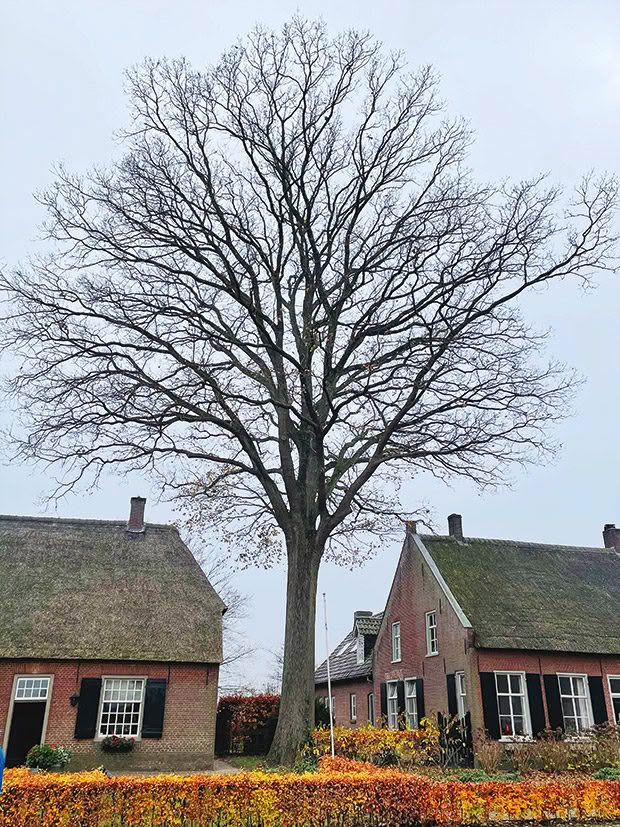
A majestic oak in the Netherlands village where Kees grew up.
They also sell artisan salami made from their venison, but carbon credits for their trees earn them more than their animals.
Kees grew up in the shade of 200-year-old oak trees in Udenhout, a small village in the south of the Netherlands. Some were planted in Napoleon’s time to shade future soldiers as they marched. “In Udenhout, Quercus robur grows to magnificent proportions. They were planted by peasant farmers in productive woodlots as well as by the village authorities,” he says.
Oak trees are permanently etched in his consciousness.

Kees has planted almost 300 oaks around the farm.
“Not only the shape and its massive pruned trunks, but especially by its use. It’s the best locally grown construction timber (in the Netherlands). It lasts centuries in farm buildings, churches, windmills, and bridges. It is also very common for all kinds of high-end furniture: tables, chairs, cabinets, beds, doors, and more.”
For hundreds of years, Dutch merchant ships were built from oak, although the local resource was exhausted by the 1500s. This led to the establishment of the first forestry plantations in the Netherlands.
It’s no surprise that Kees planted oaks, and cypress, acacia, and walnut. He chose a hybrid Q. robur x petrea line that Appletons Nursery has sold for many years due to its good form and vigorous growth.
Q. robur naturally grows in the English lowlands on heavy wet soils, while Q. petrea grows higher up on drier sites. Nursery founder Eric Appleton thinks some of the acorns brought by the first settlers from the UK were very early hybrids of the two species, not F1 crosses. Because they grow so well, they’ve been successfully propagated for nearly 200 years, half a world away from their original habitat.
Kees’ first planting block was 0.8 ha on tomo-susceptible volcanic ash soils, set out according to an agro-forestry model. His marauding Highlander cattle still graze this paddock, so Kees – cheerful, indefatigable and endlessly resourceful – hooked up an ingenious system of electric fencing to protect each tree while still allowing stock to graze 98% of the pasture.
- Kees has a unique pruning regime. Branches are trimmed off to a great height so the trunk grows as straight as possible.
The trees are now nine years old, and Kees has been meticulous with his pruning, losing just four of the 265 trees he planted. He’s taken a lot of guidance from his farm forestry mentors.
“(The late) Ian Nicholas and Ian Brown both advocated removing any branch when it reached the size of the base of your thumb. It does slow down growth, but my aim is to grow my oaks as straight as possible without creating significant pruning wounds that can cause rot.
“During the silvicultural stage (when trees are carefully managed), I’m not at all concerned about growth in itself. Only form matters. Once I have a six, eight or sometimes 10 metre straight trunk, I will let the oak develop. It will start to form big branches above the pruned section and that is when the growth will start.”
The trial block’s early performance was so promising, Kees planted another 3ha of the same species, but these haven’t grown as fast as they’re on more challenging soils. The intended rotation is at least 80 years. Kees says for the first 50 years, it will be a farm forestry project, delivering multiple benefits: grazing livestock, carbon sequestration, and improved animal welfare because of shelter the oaks provide from wind and sun.
“The real wealth I have created however, sits in the pleasure of seeing my oaks grow. Just like my forebears, only faster.”
4 THINGS YOU MAY NOT NOT ABOUT OAKS
1. The genus is Quercus which means ‘oak tree’ in Latin.
2. The oldest unequivocal records of Quercus date to the Eocene, around 45 million years ago – Homo sapiens didn’t turn up until 300,000 years ago.
3. Acorns are technically a fruit – in the wild, only one in 10,000 will germinate to become a tree.
4. People who love oaks are colloquially known as quercophiles.
6 reasons to plant oaks on your block (& in your community)
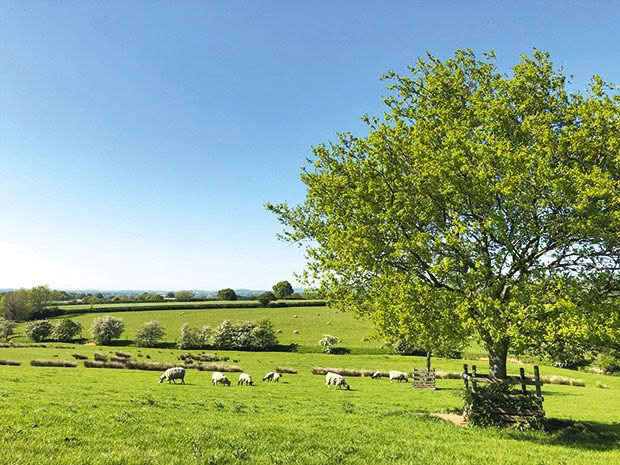
1. Shade
Many oak species, especially when grown in the middle of a paddock, develop a huge spreading canopy that creates lots of shade. On a hillside, it’s often better to plant tightly spaced rows of oaks and/or prune to encourage a more upright form. This helps to prevent stock ‘camping’ in one spot, which creates a build-up of manure that then washes into waterways during rain. The shadow of a tall, narrow tree moves more around the slope throughout the day and stock move with it.
Several species, called ‘live oaks’, are evergreen. One of the better known is the Holm oak (Q. ilex), and many Mexican species. Their small, leathery leaves stand up to wind better than their deciduous cousins.
2. Compost
“The best place to site a compost heap is under an oak tree.” I’ve spent a long time puzzling over this cryptic advice from John Jeavons, originator of the w Biointensive gardening method. I’ve come to think it’s due in part to the shade offered, but also the amount of life in the soil where oak leaves have been left to slowly mulch down.
When I lived in town, I collected woolsacks of oak leaves from the nearby arboretum. The leaves were used as mulch in the orchard, added to compost heaps, and I made a specialist leaf mould compost to make potting mix.
Rachel’s tip: use thin layers of oak leaves in compost to prevent anaerobic matting.
3. Fungi
Oaks can be inoculated with truffles, a very hit-and-miss endeavour, or mushrooms that are more reliable.
Eric is determinedly experimenting with inoculating his young oaks with saffron milkcaps. That’s partly because he likes eating them, but also because if inoculation is successful, the mycorrhizal associations will boost the growth of the trees.
4. Waste wood
Prunings and thinnings of oak trees are a famous substrate for growing mushrooms – nothing beats oak for growing shiitake mushrooms. The wood also makes good biochar and outstanding firewood if you can find no higher purpose for it.
5. Timber
It’s worth planting oaks for their timber alone. It’s famed for its beautiful grain, its strength, durability, and hardness. Oaks were a traditional tree of European coppice forests, providing a regular yield.
The wood makes fantastic flooring timber (some American white oak is imported for this purpose) and building frames.
And as William Logan Bryant’s book describes, without mighty ships built of oak, there would have been no English navy driving an era of exploration and colonisation. History would be very different.
6. Acorns for fodder
Oaks can produce multiple yields over different time frames. It can take from 5-20 years for a tree to produces acorns. The crop size varies year to year, with regular ‘masting’ (extremely heavy crops).
The size and sweetness of acorns varies between trees of the same species, even those planted in the same area. Acorns from the white oak group are sweeter, more palatable, and believed to be less likely to cause toxicity in stock.
Oaks NZ members report credible accounts of acorns proving toxic to cattle and sheep. The risk is highest to hungry sheep or cattle which suddenly gorge themselves when no other feed is available. While acorns can be an excellent supplement for stock, access to them needs careful management.
Love this story? Subscribe now!
 This article first appeared in NZ Lifestyle Block Magazine.
This article first appeared in NZ Lifestyle Block Magazine.
